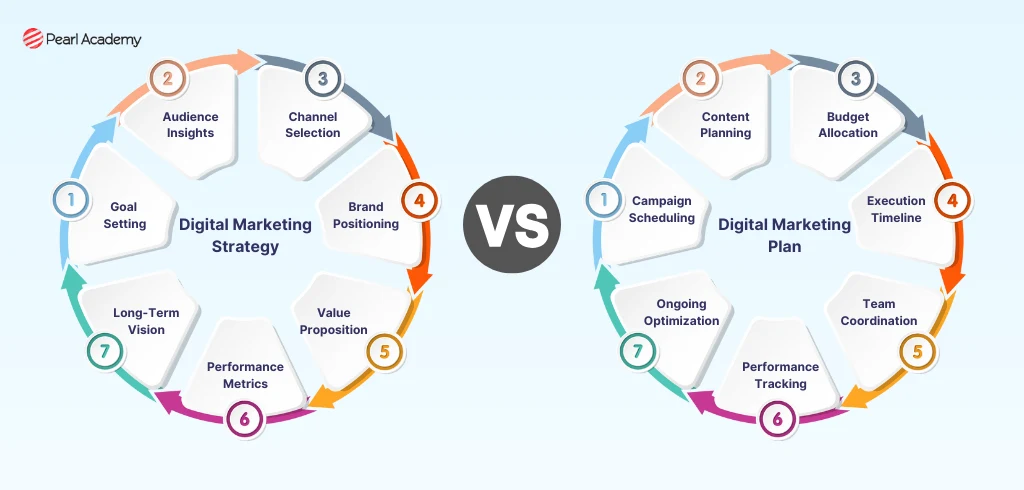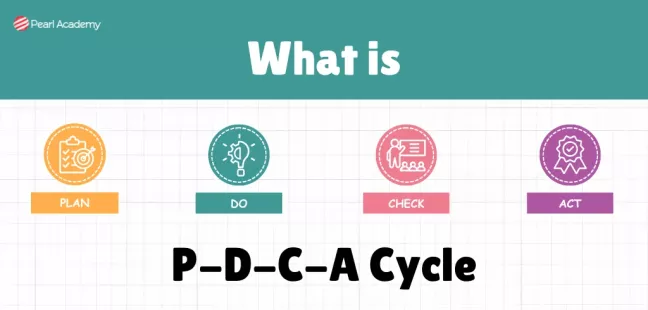Digital Marketing Strategy vs Digital Marketing Plan: Key Differences
- Editorial Team
- Published 20-Oct-2025

In the digital-first business environment, success is no longer determined solely by having an online presence. It depends on how strategically and systematically that presence is managed. Brands that thrive in the digital ecosystem don’t just execute campaigns; they operate within a clear Digital Marketing Strategy supported by a well-structured Digital Marketing Plan.
Yet, these two terms are often confused or used interchangeably. While both are interconnected, they serve very different purposes. The strategy outlines the why and what- why the brand is doing what it’s doing, and what it hopes to achieve. The plan, on the other hand, defines the how- how those goals will be met through concrete actions, budgets, and timelines.
Understanding this distinction is critical for modern marketers and business students alike, especially those aspiring to become brand strategists, campaign planners, or digital marketing leaders.
Become future-ready with our Business Programs
Know MoreWhat Is a Digital Marketing Strategy?
A Digital Marketing Strategy is the overarching framework that determines how a brand positions itself in the digital marketplace to achieve its long-term objectives. It’s the vision that connects business goals with digital capabilities, ensuring every online action has purpose and direction.
According to several Marketing Trends ReportAbouts, majority of successful businesses credit their growth to having a well-defined digital strategy. This underlines its vital role in guiding all marketing decisions.
A robust digital marketing strategy typically includes:
- Goal Setting: Defining SMART (Specific, Measurable, Achievable, Relevant, Time-bound) objectives.
- Audience Insights: Identifying customer personas based on demographics, psychographics, and digital behavior.
- Channel Selection: Choosing where to focus efforts: SEO, social media, paid search, email marketing, or influencer collaborations.
- Positioning and Value Proposition: Clarifying what makes the brand unique and why customers should care.
- Performance Framework: Outlining KPIs such as engagement rates, website traffic, conversion metrics, and customer lifetime value.
Example:
Nike’s digital marketing strategy is built on emotional storytelling and community engagement. Rather than simply promoting shoes, Nike connects its brand with empowerment, diversity, and athletic inspiration, creating a loyal global audience that resonates with its values.
What Is a Digital Marketing Plan?
A Digital Marketing Plan is the tactical roadmap that transforms strategy into actionable steps. It outlines the campaigns, tools, resources, and timelines required to execute the brand’s overarching strategy effectively.
While the strategy provides the “why” and “what,” the plan focuses on “how” and “when.”
A comprehensive marketing plan generally includes:
- Campaign Scheduling: Detailing timelines, posting frequency, and campaign durations.
- Content and Media Plans: Specifying formats (blogs, videos, ads, infographics), tone, and distribution channels.
- Budget and Resource Allocation: Assigning spending per channel, ad format, or campaign type.
- Performance Measurement: Setting KPIs like CPC (Cost Per Click), CTR (Click-Through Rate), and ROAS (Return on Ad Spend).
- Optimization Process: Regularly refining campaigns using data from analytics tools like Google Analytics, SEMrush, or HubSpot.
Example:
If a brand’s digital strategy focuses on increasing awareness among Gen Z audiences, its plan might include influencer-led TikTok campaigns, Instagram Reels, and gamified ad experiences. The plan ensures these actions are executed systematically, tracked in real time, and optimized for maximum impact.
Why Both Are Essential for Success
Many companies make the mistake of focusing on short-term digital campaigns without building a strong strategic foundation. This leads to disjointed messaging, poor audience targeting, and wasted ad spend.
A Digital Marketing Strategy provides the clarity of vision, while a Digital Marketing Plan ensures consistency and executional excellence. Without both, even large advertising budgets can fail to generate meaningful results.
A well-aligned strategy and plan ensure:
- Clarity and Direction: Everyone from copywriters to campaign managers understands business goals.
- Resource Efficiency: Time, tools, and budgets are optimized for maximum return.
- Adaptability: Plans can evolve as markets and consumer behaviors shift.
- Sustainable Growth: Consistent performance tracking leads to smarter decisions and better long-term outcomes.
In short, the strategy is the destination, and the plan is the route to reach it.
Key Differences Between Strategy and Plan
| Aspect | Digital Marketing Strategy | Digital Marketing Plan |
| Purpose | Defines what the brand aims to achieve and why | Explains how and when to achieve those goals |
| Focus | Long-term goals and brand vision | Short-term campaigns and daily operations |
| Nature | Conceptual, analytical, directional | Tactical, actionable, and measurable |
| Components | Goals, target audience, positioning, channels | Tasks, budgets, content calendars, metrics |
| Timeline | 1–5 years | Monthly or quarterly execution cycles |
| Outcome | Brand awareness, market position, customer loyalty | Leads, conversions, and measurable ROI |
| Ownership | Driven by senior leadership or brand managers | Managed by marketing teams and specialists |
Real-World Examples
Listed below are someexamples that highlight how the world’s leading brands succeed not by choosing between strategy and plan, but by integrating both seamlessly.
| Company | Strategy | Plan |
| Starbucks | Focuses on customer experience and loyalty. | Uses its mobile app, email marketing, and personalized rewards programs to retain users. |
| Coca-Cola | Promotes happiness and togetherness through global branding. | Executes region-specific campaigns, digital storytelling, and influencer collaborations to reinforce this positioning. |
| Amazon | Customer-centric approach built on convenience and personalization. | Deploys automated email recommendations, retargeting ads, and AI-driven product suggestions. |
How to Align Strategy and Plan
Achieving synergy between the two requires structured coordination and continuous analysis.
- Start with Strategic Pillars: Define 3–4 broad objectives such as brand awareness, lead generation, or customer retention.
- Create a Content and Channel Matrix: Link each strategic pillar to specific actions on chosen digital platforms.
- Set Measurable KPIs: For instance, tie “brand awareness” to metrics like reach, impressions, or video views.
- Encourage Collaboration: Marketing, sales, and analytics teams should share data to refine both plans and strategies.
- Monitor and Adapt: Review outcomes quarterly and update strategy or plan based on evolving market trends.
Career Relevance: Why Students Should Learn Both
In the evolving landscape of marketing and branding, knowing how to build and execute both strategy and plan is a fundamental skill. Professionals who understand both are better equipped to lead campaigns, measure performance, and align creative ideas with business objectives.
Learn Strategy and Planning at Pearl Academy
Pearl Academy bridges the gap between strategic vision and practical implementation through its industry-focused programs:
- The BBA in Advertising and Brand Management introduces students to marketing fundamentals, consumer behavior, and campaign design.
- The MBA in Advertising and Brand Management builds on this with advanced modules in strategic planning, leadership, digital analytics, and brand innovation.
Through live projects, internships, and exposure to real marketing tools, students learn to develop robust digital strategies and transform them into executable marketing plans that drive measurable results.
Key Takeaways
- A Digital Marketing Strategy defines a brand’s long-term direction, goals, and positioning.
- A Digital Marketing Plan translates those goals into specific actions, budgets, and timelines.
- Both are interdependent and must align for consistent growth.
- Understanding this distinction prepares future marketers to think critically and act strategically.
- Academic programs such as the BBA and MBA in Advertising and Brand Management at Pearl Academy empower students to master both.

Student Guidance Center: Our Counselors are Just a Click Away.
Conclusion
In conclusion, understanding the difference between a Digital Marketing Strategy and a Digital Marketing Plan is essential for achieving long-term business success. The strategy defines the vision and direction, while the plan ensures structured execution and measurable outcomes. When both work together, brands can create consistent, data-driven, and impactful digital campaigns. For students aspiring to lead in marketing and branding, mastering both aspects through specialised BBA programs like Pearl Academy’s BBA and MBA in Advertising and Brand Management offers a strong foundation to excel in the modern digital landscape.
FAQs
Q1. Which comes first — strategy or plan?
Ans. Strategy always comes first, as it guides every decision and defines the plan’s framework.
Q2. Can a business succeed with only a marketing plan?
Ans. Without a strategy, a plan lacks direction and consistency, often leading to fragmented efforts.
3. How often should a digital marketing plan be updated?
Ideally every quarter, to reflect new data, changing customer preferences, and emerging trends.
4. What skills are needed to excel in strategy and planning?
Analytical thinking, creativity, data interpretation, communication, and adaptability are key.
5. Why should students learn both?
Because employers today value professionals who can bridge strategy and execution to deliver measurable brand outcomes.
Tags
- #Business
Pearl Admission Enquiry
Subscribe to Pearl Blogs
By clicking the "Subscribe" button, I agree and accept the privacy policyyy of PEARL.



















































